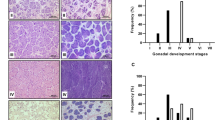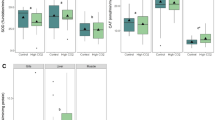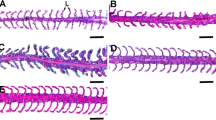Abstract
Cell proliferation and apoptosis were investigated in tissues of two bivalve species, Arctica islandica from the German Bight (age of bivalves: 33–98 years) and Iceland (7–148 years) and Aequipecten opercularis from the English Channel (2–4 years). High proliferation rates (10% nuclei dividing) and apoptosis in tissues of A. opercularis were in line with high-energy throughput and reduced investment into antioxidant defence mechanisms in the scallop. In contrast, cell turnover was slow (<1% nuclei dividing) in A. islandica and similar in mantle, gill and adductor muscle between young and old individuals. In the heart, cell turnover rates decreased with age, which indicates less-efficient removal of damaged cells in ageing A. islandica. Cell turnover rates, mass specific respiration and antioxidant enzyme activities were similar in German Bight and Iceland ocean quahog. Variable maximum life expectancies in geographically separated A. islandica populations are determined by extrinsic factors rather than by fundamental physiological differences.






Similar content being viewed by others
References
Abele D, Strahl J, Brey T, Philipp E (2008) Imperceptible senescence-ageing in the ocean quahog Arctica islandica. Free Radic Res 42:474–480
Abele D, Brey T, Philipp E (2009) Bivalve models of aging and the determination of molluscan lifespan. Exp Gerontol 44:307–315
Aebi H (1984) Catalase in vitro. Methods Enzymol 105:121–126
Ansell AD, Dao J-C, Mason J (1991) Three European scallops: Pecten maximus, Chlamys (Aequipecten) opercularis and C. (Chlamys) varia. In: Shumway SE (ed) Scallops: biology, ecology and aquaculture. Elsevier, Amsterdam, pp 715–751
Anversa P, Fitzpatrick D, Argani S, Capasso JM (1991) Myocyte mitotic division in the aging mammalian rat heart. Cir Res 69:1159–1164
Arntz WE, Brey T, Gallardo VA (1994) Antarctic zoobenthos. Oceanogr Mar Biol Annu Rev 32:241–304
Bauer G (1992) Variation in the life span and size of the freshwater pearl mussel. J Anim Ecol 61:425–436
Bayne BL, Thompson RJ, Widdows J (1976) Physiology I. In: Bayne BL (ed) Marine mussels. Their ecology and physiology. Cambridge University Press, Cambridge, pp 121–206
Begum S, Basova L, Strahl J, Sukhotin A, Heilmeyer O, Philipp E, Brey T, Abele D (2009) A metabolic model for the ocean quahog Arctica islandica—effects of animal mass and age, temperature, saliniy, and geography on respiration rate. J Shellfish Res 28:533–539
Bodnar AG (2009) Marine invertebrates as models for aging research. Exp Gerontol 44:477–484
Bradford MM (1976) A rapid and sensitive method for the quantitation of microgram quantities of protein utilizing the principle of protein-dye binding. Anal Biochem 72:248–254
Dahlgren TG, Weinberg JR, Halanych KM (2000) Phylogeography of the ocean quahog (Arctica islandica): influences of paleoclimate on genetic diversity and species range. Mar Biol 137:487–495
Ebert TA (2008) Longevity and lack of senescence in the red sea urchin Strongylocentrotus franciscanus. Exp Gerontol 43:734–738
Harman D (1956) Aging: a theory based on free radical and radiation biology. J Gerontol 11:298–300
Heilmayer O, Brey T (2003) Saving by freezing? Metabolic rates of Adamussium colbecki in a latitudinal context. Mar Biol 143:477–484
Heilmayer O, Brey T, Storch D, Mackensen A, Arntz WE (2004) Population dynamics and metabolism of Aequipecten opercularis (L.) from the western English Channel (Roscoff, France). J Sea Res 52:33–44
Ivanina AV, Sokolova IM, Sukhotin AA (2008) Oxidative stress and expression of chaperones in aging mollusks. Comp Biochem Physiol, B 150:53–61
Jones DS (1980) Annual cycle of shell growth increment formation in two continental shelf bivalves and its paleoecologic significance. Paleobiology 6:331–340
Kaiser MJ, Clarke KR, Hinz H, Austen MCV, Sommerfield PJ, Karakassis I (2006) Global analysis of response and recovery of benthic biota to fishing. Mar Ecol Prog Ser 311:1–14
Kajstura J, Leri A, Finato N, Di Loreto C, Beltrami C (1998) Myocyte proliferation in end-stage cardiac failure in humans. Proc Natl Acad Sci USA 95:8801–8805
Karsner HT, Saphir O, Todd TW (1925) The state of the cardiac muscle in hypertrophy and atrophy. Am J Pathol 1:351–371
Kirkwood TBL (2005) Understanding the odd science of aging. Cell 120:437–447
Leri A, Franco S, Zacheo A, Barlucchi L, Chimenti S, Limana F, Nadal-Ginard B, Kajstura J, Anversa P, Blasco MA (2003) Ablation of telomerase and telomere loss leads to cardiac dilatation and heart failure associated with p53 upregulation. Eu Mol Biol Organ 22:131–139
Liu D, Li C, Chen Y, Burnett C, Liu XY, Downs S, Collins RD, Hawiger J (2004) Nuclear import of proinflammatory transcription factors is required for massive liver apoptosis induced by bacterial lipopolysaccharide. J Biol Chem 279:48434–48442
Livingstone DR, Lips F, Garcia Martinez P, Pipe RK (1992) Antioxidant enzymes in the digestive gland of the common mussel Mytilus edulis. Mar Biol 112:265–276
Mangel M (2003) Environment and longevity: the demography of the growth rate. In: Carey JR, Tuljapurkar S (eds) Life span: evolutionary, ecological and demographic perspectives, vol 29. Population Council Inc, New York, pp 57–70
Mann R (1982) The seasonal cycle of gonadal development in Arctica islandica from the southern New England shelf. Fish Bull 80:315–326
Moore JD, Trueman ER (1971) Swimming of the scallop, Chlamys opercularis (L.). J Exp Mar Biol Ecol 6:179–185
Moore MJ, Leavitt DF, Shumate AM, Alatalo P, Stegemann JJ (1994) A cell proliferation assay for small fish and aquatic invertebrates using bath exposure to bromodeoxyuridine. Aquat Toxicol 30:183–188
Murawski SA, Ropes JW, Serchuk FA (1982) Growth of the ocean quahog, Arctica islandica, in the Middle Atlantic Bight. Fish Bull 80:21–34
Nicol D (1951) Recent species of the Veneroid pelecypod Arctica. J Wash Acad Sci 41:102–106
Oeschger R, Storey KB (1993) Impact of anoxia and hydrogen sulphide on the metabolism of Arctica islandica L. (Bivalvia). J Exp Mar Biol Ecol 170:213–226
Pearl R (1928) The rate of living. Alfred Knopf, New York
Philipp EER, Abele D (2009) Masters of longevity: lessons from long-lived bivalves—a mini-review. Gerontology. doi: 10.1159/000221004
Philipp E, Brey T, Pörtner H-O, Abele D (2005a) Chronological and physiological ageing in a polar and a temperate mud clam. Mech Ageing Dev 126:589–609
Philipp E, Pörtner H-O, Abele D (2005b) Mitochondrial ageing of a polar and a temperate mud clam. Mech Ageing Dev 126:610–619
Philipp E, Heilmayer O, Brey T, Abele D, Pörtner H-O (2006) Physiological ageing in a polar and a temperate swimming scallop. Mar Ecol Prog Ser 307:187–198
Philipp E, Schmidt M, Gsottbauer C, Sänger AM, Abele D (2008) Size- and age-dependent changes in adductor muscle swimming physiology of the scallop Aequipecten opercularis. J Exp Biol 211: 2492–2501
Poss KD, Wilson LG, Keating MT (2002) Heart regeneration in zebrafish. Science 298:2188–2190
Ragnarsson SA, Thórarinsdottier GG (2002) Abundance of ocean quahog, Arctica islandica, assessed by underwater photography and a hydraulic dredge. J Shellfish Res 21:673–676
Rijinsdorp AD, van Leeuwen PI (1996) Changes in growth of North Sea plaice since 1951 in relation to density, eutrophication, beam-trawl effort, and temperature. ICES J Mar Sci 53:1199–1213
Román G, Campos MJ, Acosta CP (1996) Relationships among environment, spawning and settlement of queen scallop in the Ría de Arosa (Galicia, NW Spain). Aquacult Int 4:225–236
Rumohr H, Kujawski T (2000) The impact of trawl fishery on the epifauna of southern North Sea. ICES J Mar Sci 57:1389–1394
Schöne BR, Freyre Castro AD, Fiebig J, Houk SD, Oschman W, Kröncke I (2004) Sea surface water temperatures over the period 1884–1983 reconstructed from oxygen isotope ratios of a bivalve mollusk shell (Arctica islandica, southern North Sea). Palaeogeogr Palaeoclimatol Palaeoecol 212:215–232
Schöne BR, Houk SD, Freyre Castro AD, Fiebig J, Oschman W (2005) Daily growth rates in shells of Arctica islandica: assessing sub-seasonal environmental controls on a long-lived Bivalve Mollusk. Palaios 20:78–92
Sokolova IM (2009) Apoptosis in molluscan immune defence. ISJ 6:49–58
Sokolova IM, Evans S, Hiughes FM (2004) Cadmium-induced apoptosis in oyster hemocytes involves disturbance of cellular energy balance but no mitochondrial permeability transition. J Exp Biol 207:3369–3380
Strahl J, Philipp E, Brey T, Broeg K, Abele D (2007) Physiological aging in the Icelandic population of the ocean quahog Arctica islandica. Aquat Biol 1:77–83
Sunila I, LaBanca J (2003) Apoptosis in the pathogenesis of infectious diseases of the eastern oyster Crassostrea virginica. Dis Aquat Org 56:163–170
Taylor AC (1976) Burrowing behaviour and anaerobiosis in the bivalve Arctica islandica (L.). J Mar Biol Assoc UK 56:95–109
Thompson I, Jones DS, Ropes JW (1980) Advanced age for sexual maturity in the ocean quahog Arctica islandica (Mollusca: Bivalvia). Mar Biol 57:35–39
Waller TR (1991) Evolutionary relationships among commercial scallops (Mollusca: Bivalvia: Pectinidae). In: Shumway SE (ed) Scallops: biology, ecology and aquaculture. Elsevier, Amsterdam, pp 1–72
Wanamaker AD, Heinemeier J, Scourse JD, Richardson CA, Butler PG, Eiríksson J, Knudsen KL (2008) Very long-lived mollusk confirm 17th century ad tephra-based radiocarbon reservoir ages for north Icelandic shelf waters. Radiocarbon 50:399–412
Wiltshire KH, Manly BFJ (2004) The warming trend at Helgoland roads, North Sea: phytoplankton response. Helgol Mar Res 58:269–273
Witbaard R, Bergman MJN (2003) The distribution and population structure of the bivalve Arctica islandica L. in the North Sea: what possible factors are involved? J Shellfish Res 50:11–25
Witbaard R, Klein R (1994) Long-term trends on the effects of the southern North Sea beam trawl fishery on the bivalve mollusc Arctica islandica L. (Mollusca, Bivalvia). ICES J Mar Sci 51:99–105
Witbaard R, Duineveld GCA, de Wilde PAWJ (1999) Geographical differences in growth rates of Arctica islandica (Molluska: Bivalvia) from the North Sea and adjacent waters. J Mar Biol Assoc UK 79:907–915
Zielinski S, Pörtner HO (2000) Oxidative stress and antioxidative defense in cephalopods: a function of metabolic rate or age? Comp Biochem Physiol, B 125:147–160
Ziuganov V, Miguel ES, Neves RJ, Longa A, Fernandez C, Amaro R, Beletsky V, Popkovitch E, Kaliuzhin S, Johnson T (2000) Life span variation of the freshwater pearl shell: a model species for testing longevity mechanisms in animals. Ambio 29:102–105
Acknowledgments
We thank Gudmundur Vidir Helgasson, Halldór Pálmar Halldórsson and Reynir Sveinsson from Sandgerdi Marine Station (University of Iceland) as well as Siggeir Stefánsson and Silvia Hardenberg for support during the field work in Iceland. Thanks to Michael Janke and the Uthoern crew for fishing North Sea A. islandica, Sabine Schaefer who helped with the immuno-histochemical techniques, and Stefanie Meyer and Kerstin Beyer who technically supported our study. The cooperative project between the working groups of PD Dr. Abele (Alfred-Wegener Institute) and Prof. Dr. Dringen (University of Bremen) was financed by the Deutsche Forschungsgemeinschaft (DFG), grant numbers AB124/10-1 and DR262/10-1.
Author information
Authors and Affiliations
Corresponding author
Additional information
Communicated by J. P. Grassle.
Rights and permissions
About this article
Cite this article
Strahl, J., Abele, D. Cell turnover in tissues of the long-lived ocean quahog Arctica islandica and the short-lived scallop Aequipecten opercularis . Mar Biol 157, 1283–1292 (2010). https://doi.org/10.1007/s00227-010-1408-6
Received:
Accepted:
Published:
Issue Date:
DOI: https://doi.org/10.1007/s00227-010-1408-6




